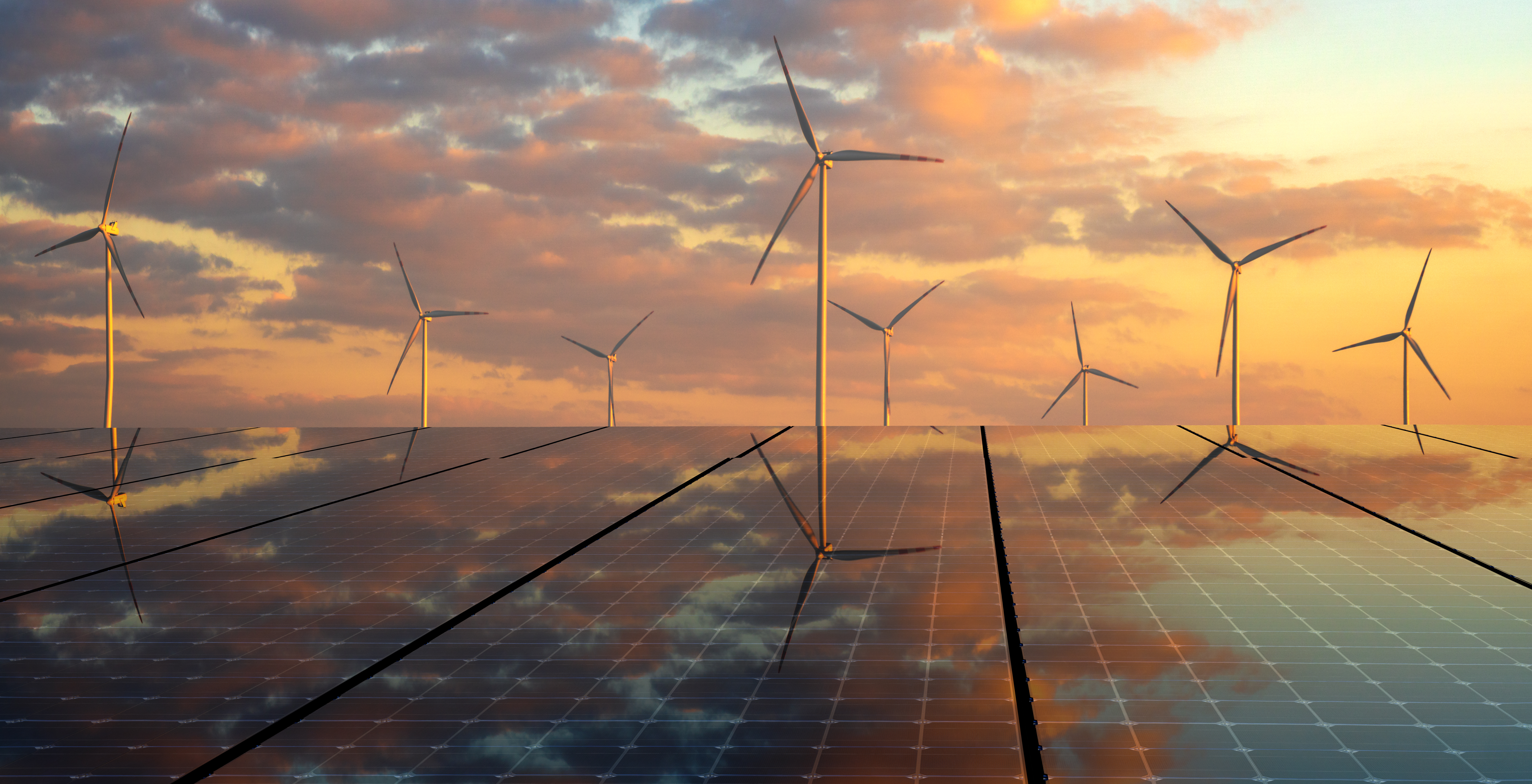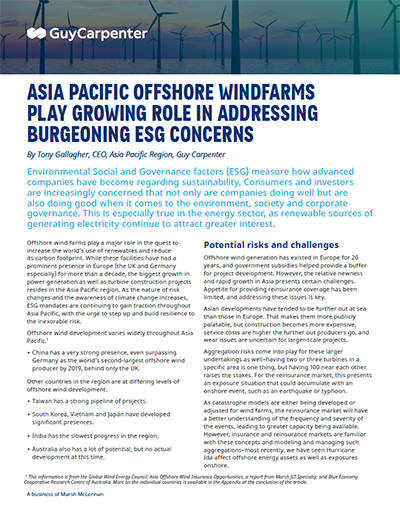Asia Pacific Offshore Windfarms Play Growing Role in Addressing Burgeoning ESG Concerns
For more information, please download the full article

Environmental Social and Governance factors (ESG) measure how advanced companies have become regarding sustainability. Consumers and investors are increasingly concerned that not only are companies doing well but are also doing good when it comes to the environment, society and corporate governance. This is especially true in the energy sector, as renewable sources of generating electricity continue to attract greater interest.
Offshore wind farms play a major role in the quest to increase the world’s use of renewables and reduce its carbon footprint. While these facilities have had a prominent presence in Europe (the UK and Germany especially) for more than a decade, the biggest growth in power generation as well as turbine construction projects resides in the Asia Pacific region. As the nature of risk changes and the awareness of climate change increases, ESG mandates are continuing to gain traction throughout Asia Pacific, with the urge to step up and build resilience to the inexorable risk.
Offshore wind development varies widely throughout Asia Pacific.
Other countries and territories in the region are at differing levels of offshore wind development.
Offshore wind generation has existed in Europe for 20 years, and government subsidies helped provide a buffer for project development. However, the relative newness and rapid growth in Asia presents certain challenges. Appetite for providing reinsurance coverage has been limited, and addressing these issues is key.
Asian developments have tended to be further out at sea than those in Europe. That makes them more publicly palatable, but construction becomes more expensive, service costs are higher the further out producers go, and wear issues are uncertain for larger-scale projects.
Aggregation risks come into play for these larger undertakings as well–having two or three turbines in a specific area is one thing, but having 100 near each other raises the stakes. For the reinsurance market, this presents an exposure situation that could accumulate with an onshore event, such as an earthquake or typhoon.
As catastrophe models are either being developed or adjusted for wind farms, the reinsurance market will have a better understanding of the frequency and severity of the events, leading to greater capacity being available. However, insurance and reinsurance markets are familiar with these concepts and modeling and managing such aggregations–most recently, we have seen Hurricane Ida affect offshore energy assets as well as exposures onshore.
Weather and other natural disaster potentials differ significantly compared to the frequency and severity expected in Europe, but models and techniques do exist to assess these risks. The most significant difference is the potential for typhoons–or tropical cyclones. The need for partnering with government entities in China–by far the biggest growth area in the region–also presents certain challenges. In the longer term, we would expect the traditional reinsurance market to provide capacity for these wind farms.
In addition, the technology and scale are still relatively new in the region. Specialized vessels need to be used, and supply chain and manufacturing capacity for the turbines are still evolving. Innovation in production has increased the average turbine size in China, adding to uncertainty: from 4 MW in 2018 to 5 MW in 2020, with 7 MW expected by 2025.
Further technological developments by HZ Wind power, a subsidiary of the state-owned China Shipbuilding Industry Corporation, are leading to development of a 210-meter rotor for offshore wind turbines, with a capability of 10 MW. New technology leads to increased risk management as the equipment is installed and tested over time.
China and Taiwan are viewed as high-opportunity markets. While Chinese developments have been driven mostly by domestic investment, Taiwan is attracting more foreign participants. China has an extremely formidable pipeline of projects (about USD 180 billion) until 2025. Taiwan is also strong (about USD 20 billion) over the same period, which is high compared to larger countries. USD 2 billion in premium generation is expected by 2025.
There is high potential for coverage against losses due to delay in start-up, contractor’s error, business interruption and marine cover, with sub-sea cables and prospective technical failure of foundations presenting possible issues. The capacity to support these covers is already available in the market, but as the size and complexity of the offshore wind farms grow, the reinsurance market will need to expand to accommodate these exposures.
Parametric solutions could work well. For example, if coverage for a set amount was based on sustained winds in miles per hour affecting an offshore wind facility, that claimant would have confidence in knowing they would receive payment quickly as long as that wind threshold was reached, providing needed capital without having to present the detailed loss information otherwise necessary for a property claim. The other key factor here will be measurement of real-time data.
The biggest challenge remains to be addressing the potential for natural catastrophe. As the technology of turbines evolves, they are expected to be more resilient regarding wind exposure. However, this is largely untested in the quantities and weather conditions that would be encountered by these facilities. The modeling of wind farms is work that has already started and will assist in quantifying the potential loss in any one event.
Guy Carpenter’s global analytical platform facilitates our ability to quantify the performance of different solutions across all classes and territories, and measure them against specific business metrics. This methodical consistency helps clients predict portfolio performance with confidence, including assessment of accumulated exposures. Guy Carpenter’s G-Cat® models, combined with market models, are being used to quantify the natural hazard exposure to these wind farms to enable reinsurance solutions to support ESG ambitions in Asia.
A potential solution could be to separate the natural catastrophe aspect into government pools supported by reinsurance, segregated from other property risks inherent in offshore windfarm development. There is already extensive natural catastrophe capacity available for on-land exposures in this region.
Reducing uncertainty in this segment continues to be key in the advancement of this industry. As the business grows and technology advances, experience could demonstrate a reduced risk and consequently mean less expense related to this coverage. Guy Carpenter will continue to analyze the evolution of the offshore windfarm market, enabling us to deliver innovative treaty and facultative solutions for all lines of business across the sector.
*This information is from the Global Wind Energy Council; Asia Offshore Wind Insurance Opportunities, a report from Marsh JLT Specialty; and Blue Economy Cooperative Research Centre of Australia. More on the individual countries is available in the Appendix at the conclusion of the article.

For more information, please download the full article